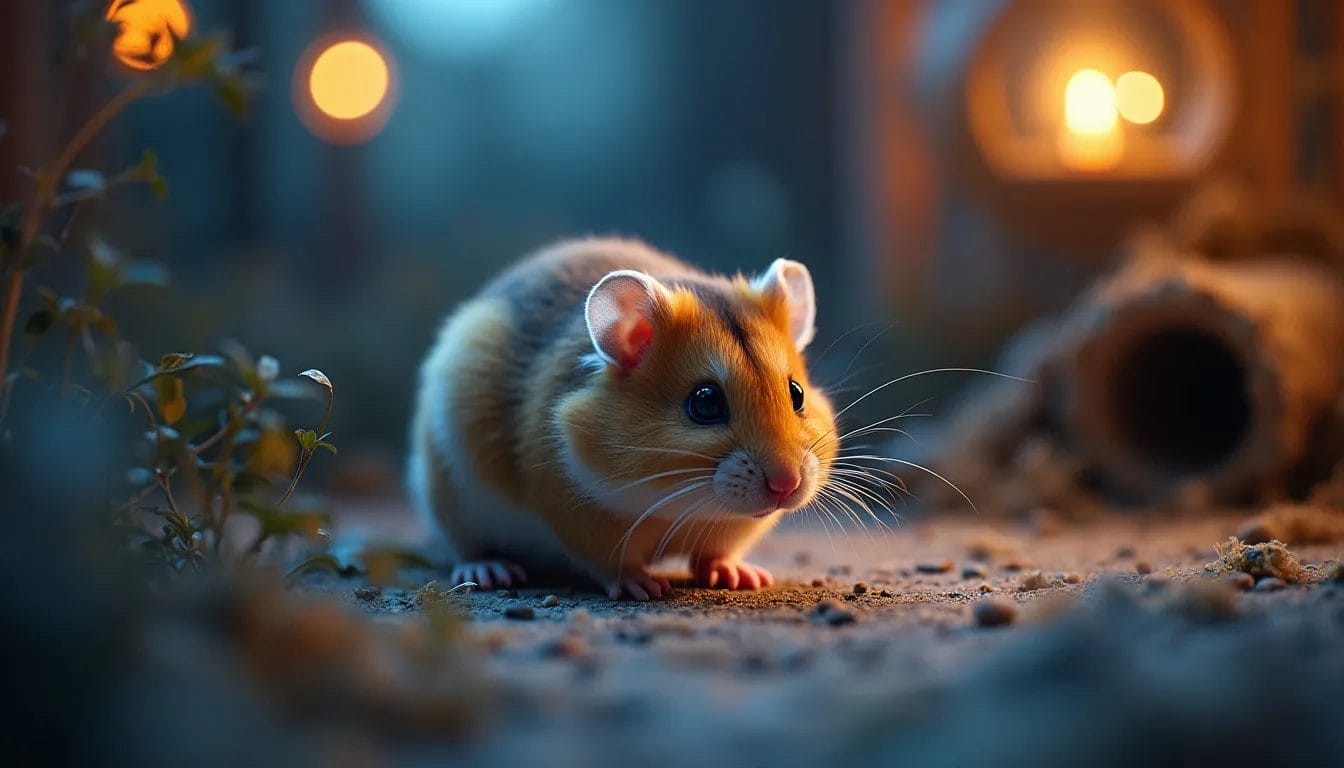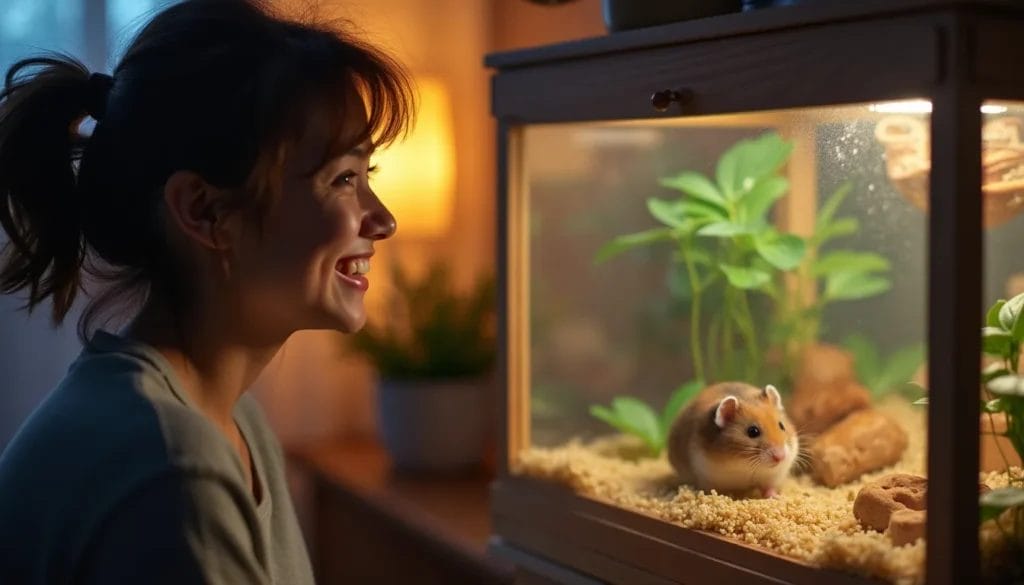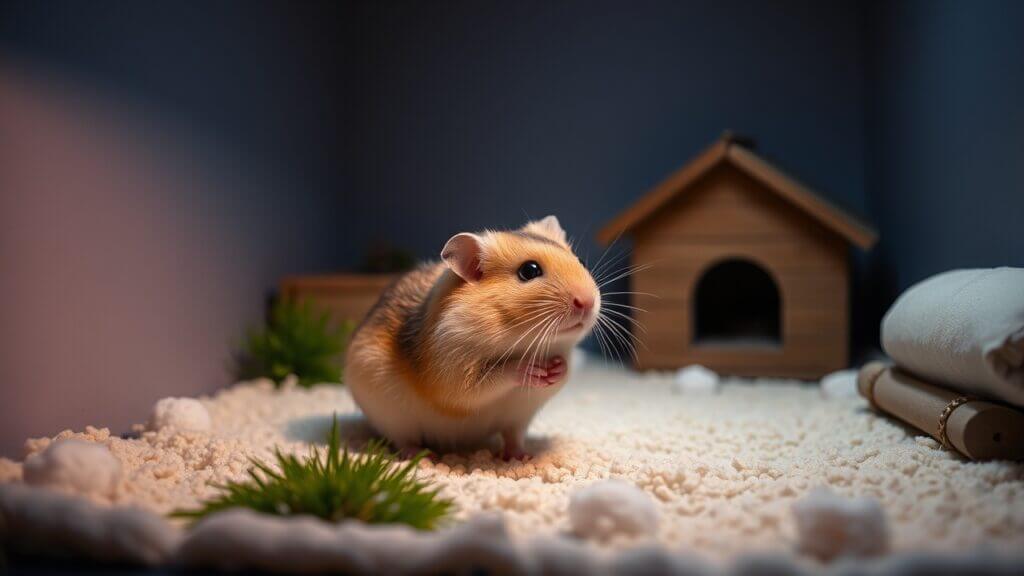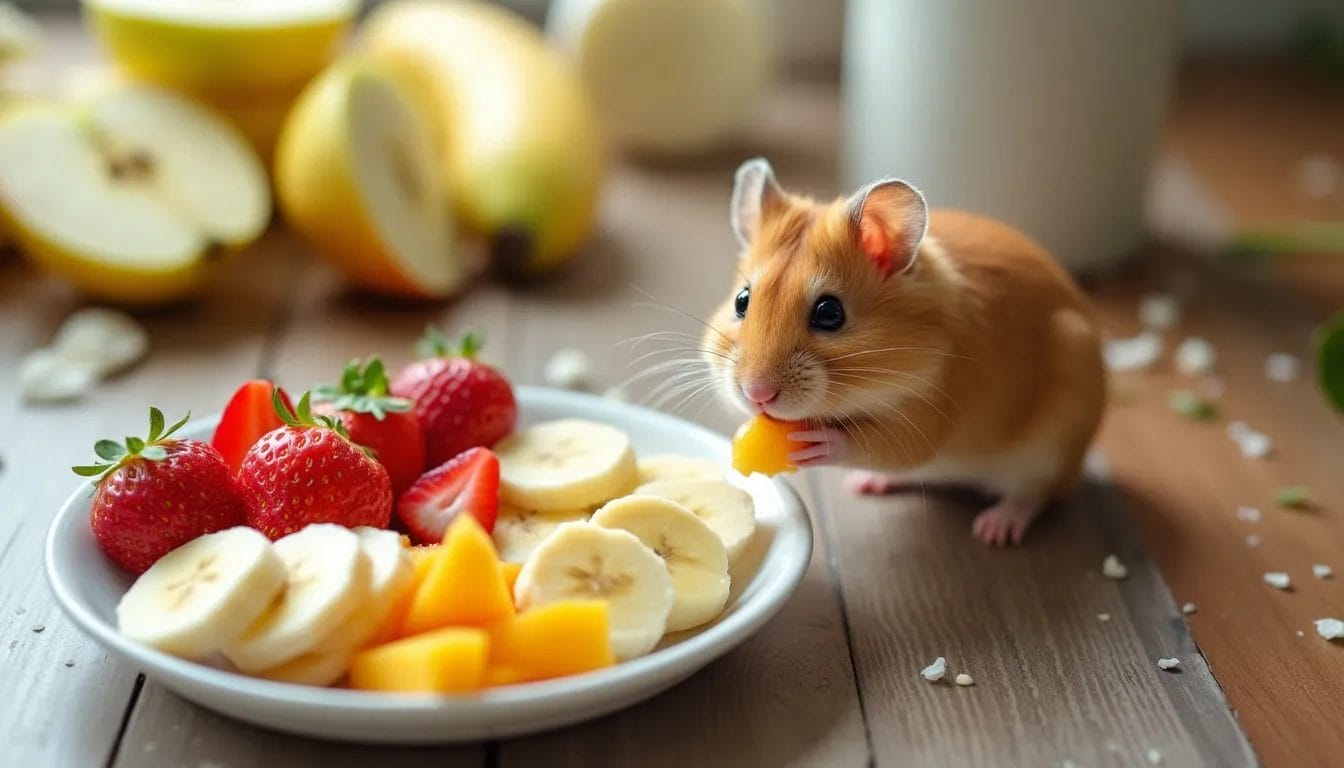
TL;DR: A hamster’s vision plays a crucial role in their behavior and needs. By creating optimal environments and reflecting on personal care experiences, owners can improve their pet’s well-being and foster deeper connections.
Have you ever watched your playful hamster dart around its cage at night, seemingly unbothered by the darkness? It’s a curious sight, especially if you’ve ever stumbled in the dark on your way to refill its food bowl. Like many pet owners, I often wondered—can hamsters actually see in the dark, or are they just relying on instinct? In this post, we’ll unravel the mysteries of hamster vision and discover how their tiny eyes adapt to low light conditions.
The Unique Anatomy of Hamster Eyes
Hamsters are small, furry creatures that captivate many animal enthusiasts. One of their most distinctive features is their eyes. These little windows to the world are not just adorable; they play a crucial role in how hamsters see and interact with their environment. Let’s dive into the unique anatomy of hamster eyes and explore their fascinating adaptations.
Structure of Hamster Eyes Explained
The anatomy of hamster eyes is quite remarkable. They have relatively large eyes compared to their head size. This feature enhances their ability to see in low light conditions. But what exactly makes their eyes so special?
- Cornea: The outer layer of the eye, which helps focus light.
- Iris: The colored part of the eye that controls how much light enters.
- Pupil: The opening that allows light in, adjusting in size based on light conditions.
- Retina: The thin layer at the back of the eye, containing cells that react to light.
- Tapetum Lucidum: A layer that reflects light, enhancing night vision.
Relative to their small size, the hamster’s large eyes are perfect for capturing as much light as possible, proving vital for their survival. This high sensitivity to light enables them to be active during dawn and dusk when they hunt for food. The combination of these structures creates a powerful visual system for such a small animal.
Comparison with Other Small Animals
When we look at other small animals, a few similarities and differences emerge. For instance, mice also have large eyes, helping them navigate in dim lighting. However, many small mammals have different adaptations depending on their habitats. Some animals, like squirrels, have more advanced color vision because they spend time in varied light conditions. There’s always a trade-off in nature.
Here’s a quick comparison of the eye structures of hamsters and two other small mammals:
| Animal | Eye Size (relative to head) | Notable Feature |
|---|---|---|
| Hamster | Large | Enhanced night vision |
| Mouse | Medium | Sharp motion detection |
| Squirrel | Small | Good color vision |
From this table, we can see how different species evolve according to their needs. Hamsters, being nocturnal and prey animals, have developed adaptations suited for survival.
Role of the Tapetum Lucidum in Night Vision
The tapetum lucidum is a fascinating component of hamster eyes. It’s not just any reflective surface; it enhances their ability to see in the dark. By reflecting light that enters the eye back through the retina, it increases the light sensitivity. This means hamsters can see even in very low light.
Hamsters can see in light as low as 0.1 lux. To put that into perspective, a full moon night provides around 0.1 lux of light. This capability allows hamsters to thrive at night when their predators are less active. In an environment where safety is paramount, such adaptations are life-saving.
“The fascinating adaptations of small animals like hamsters highlight nature’s ingenuity.” – Expert on Animal Physiology
Through these adaptations, hamsters have evolved unique features that assist them in navigating their environments. Their eyes are built not just for seeing but for survival. As you observe a hamster in its habitat, notice how they navigate seamlessly, guided by their incredible vision.
Behavioral Adaptations to Darkness
Nocturnal Habits of Hamsters
Hamsters are interesting creatures, particularly when it comes to their sleep and activity patterns. Most hamsters are classified as nocturnal, which means they are mainly active during the night. They have evolved to thrive in low-light conditions, making them better suited to explore and forage when it’s dark.
- Syrian hamsters are more solitary and often have varied habits.
- Dwarf hamsters tend to be more social and may act differently at night.
When keeping a hamster, it’s essential to understand these nocturnal habits. If he is scurrying about at midnight, it’s just his nature at work! Many hamster owners notice that their pets become most lively after sunset.
How Darkness Affects Hamster Activity
Darkness has a significant impact on the activity of hamsters. Observations show that about 90% of their activity occurs after sunset among nocturnal species. This peak in activity leads to several behaviors, such as running on wheels, foraging for food, and engaging in playful antics.
| Time of Day | Activity Level (%) |
|---|---|
| Sunset to Midnight | 90% |
| Midnight to Dawn | 75% |
| Dawn to Sunset | 10% |
In darkness, hamsters’ sensitive whiskers come into play. They help navigate, explore, and interact with their surroundings. Their vision might not be strong, but these adaptations make them masters in low-light conditions. Isn’t it fascinating how nature equips animals to thrive in their environments?
Understanding how darkness affects these little creatures is vital for any hamster owner. A pet’s nighttime activities aren’t just random; they are instinctive behaviors. For example, it is common to hear the sound of a hamster wheel spinning in the middle of the night or witness a small furry friend digging in their bedding. These are signs of a comfortable, happy hamster.
Personal Anecdote about Hamster Habits

Reflecting on my own experiences, there was a time when I had a Syrian hamster named Charlie. He was a bundle of energy. Each night, as soon as the lights dimmed, Charlie would become a mini tornado, racing around his enclosure. His little feet would scamper noisily, and I could hear him playfully nudging toys and treats.
Sometimes, I wondered if he was trying to tell me something through his antics. Perhaps he wanted me to understand that nighttime was his time to shine. Every evening brought a new performance as I watched with a mix of amusement and admiration. That was Charlie’s world after dark, and it made it clear that the night was where he felt most alive.
Many hamster owners share similar stories. These nocturnal habits can form a bond between pet and owner, building a special connection. As the quote from an animal behaviorist wisely states,
“Understanding their behavior can help you create a more nurturing environment for your pet.”
With this knowledge, owners can tailor their care routines accordingly, ensuring their pets flourish.
Moreover, acknowledging their nocturnal nature enriches the living experience for both pet and owner. Whether you’ve witnessed racing wheels or your furry companion snuggled up after a long night of exploration, these behaviors reveal the charm of hamsters after dark. It’s a beautiful reminder of how unique each creature is, adapting and thriving in their own ways.
The Importance of Proper Lighting in Hamster Habitats
When it comes to hamsters, their habitat is crucial for their health and happiness. One often overlooked aspect is proper lighting. Why should lighting matter so much? Because it can significantly affect a hamster’s behavior, well-being, and overall quality of life.
Recommendations for Cage Lighting
Ideal lighting for hamsters should mimic natural conditions. Here are some recommendations for cage lighting:
- Light Intensity: Aim for a comfortable light level of around 150 lumens. This level is bright enough for visibility but not so bright as to be overwhelming.
- Natural Light Simulation: If possible, position the cage near a window. Natural light can aid in regulating their circadian rhythms, but avoid direct sunlight to prevent overheating.
- Light Cycle: Implement a light cycle of around 12 hours of light, followed by 12 hours of darkness. This pattern is similar to their natural habitat.
Effects of Bright Lights on Hamster Well-Being
Bright lights can lead to multiple issues for hamsters. They are not designed to cope well with excessive illumination:
- Stress: Overly bright environments can stress hamsters. Excessive light can disrupt their normal behavior and lead them to feel vulnerable.
- Health Issues: Long-term exposure to bright lights may result in anxiety disorders or hinder their natural instincts. Hamsters are typically nocturnal creatures. They thrive in dim conditions at night.
- Disrupted Sleep Patterns: Too much light during their rest periods can lead to sleep deprivation. This can affect their health and mood over time.
The key takeaway here? Proper lighting is not just about visibility; it’s about creating a serene environment where hamsters can thrive.
Exemplary Care Tips Based on Hamster Types
Different types of hamsters may have varying needs regarding lighting. Here are some pointers for care based on hamster species:
- Syrian Hamsters: These hamsters prefer a cozy, dark environment for most of the day. They may do best in a slightly shaded area with indirect light.
- Dwarf Hamsters: They are a bit more adaptable to light, but they still prefer lower levels. Use gentle, warm lighting.
- Roborovski Hamsters: These little guys are very sensitive. Keep their habitat dim and allow them to explore in low-light conditions.
The important thing to remember is that *each type of hamster has unique requirements*. Meeting those needs can lead to healthier, happier pets.
Data on Recommended Light Levels
Below is a summarized table showing recommended light levels for different hamster environments:
| Light Level | Description |
|---|---|
| 150 lumens | Recommended for comfort without causing stress |
Data indicates that keeping this light intensity is crucial for fostering their natural behaviors. After all,
“Creating a balanced habitat is essential for your hamster’s happiness.” – Expert Animal Care Advocate
Conclusion
Lighting is crucial not just for vision but also for healthy behaviors in hamsters. Properly managing the light in your hamster’s habitat can mean the difference between a happy, healthy pet and one that feels stressed and out of sorts. It’s a simple change that yields substantial benefits. Remember to consider your hamster’s unique needs to create an environment where they can truly thrive.
Common Misconceptions About Hamster Vision

As a pet owner, understanding how your furry friend sees the world is crucial. Yet, many hold misconceptions about hamster vision. It’s essential to clear up these misunderstandings to provide the best care for these small animals. Are hamsters really poor at seeing in light? Do they require total darkness to thrive? Let’s dive into some of the most common myths and facts.
Do They Need Complete Darkness?
One of the most pervasive myths is that hamsters need complete darkness to feel comfortable. Surprising, isn’t it? In fact, it is not true. While hamsters are primarily nocturnal, meaning they are active at night, they do not thrive in total darkness.
In reality, hamsters have a unique ability to see well in low light. Their eyes are adapted to detect movement, which helps them avoid predators at night. However, complete darkness can cause them stress. Imagine being confined in a pitch-black room! It’s unnerving, right? Pets are no different.
Why Do They Prefer Low Light?
Hamsters are crepuscular creatures. This means they are most active during dawn and dusk. They prefer environments that mimic the natural light conditions of their original habitats. Here are a few points to keep in mind:
- Low Light Conditions: Hamsters feel safest when it’s dim, but not entirely dark.
- Environmental Enrichment: Ensure their habitats have areas that replicate natural conditions.
- Routine Check: Avoid extreme lighting shifts—gradual transitions keep them calm.





